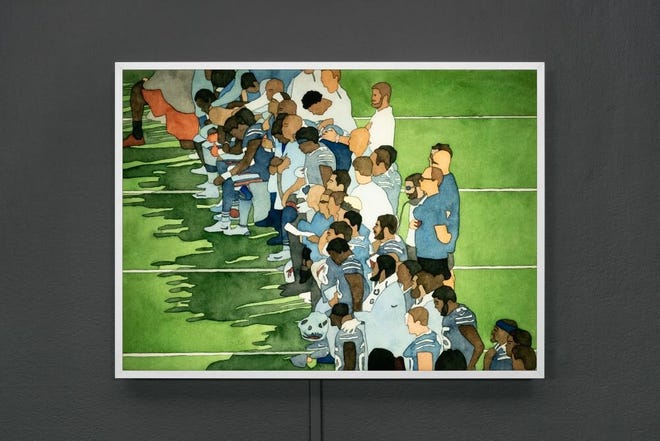How to Take Apart an Image and Put It Back Together Kota Ezawa

Hearing the subject of Kota Ezawa's animated art exhibit, it would be easy to fall into our usual divisive camps.
The focus of the exhibit is the "Take a Knee" protest launched during the National Anthem by former NFL quarterback Colin Kaepernick. To many, the protests made Kaepernick either a hero who helped launch a national movement against an inequitable criminal justice system or a villain who denigrated America's flag and all it represents.
But to jump to conclusions about the exhibition would be to deny the subtle power of Ezawa's work, to ignore a simplicity that belies its detail and depth, both in creation and in message.
In truth, people on both sides of the visceral debate can witness the exhibit, called "National Anthem," and be moved and, perhaps, even more understanding of each other.
Exhibit came from the Whitney in NYC

Deborah Ronnen, owner of Deborah Ronnen Fine Art, saw the exhibit over a year ago at the Whitney Museum of American Art in New York City. She now brings the exhibit to Rochester, where it will show through Nov. 7.
"I was so personally moved by it that I set about designing an exhibit that could work in Rochester," she said.
Ronnen is an art dealer who works with private clients but occasionally creates "pop-up" exhibits locally.
"I do exhibits and work with clients privately from my home space," she said. "When I believe that it requires a broader audience I actually rent space so that I can show this work to everyone in Rochester. I just so deeply felt that this needed to be shared with as many people as possible."
The exhibit is at R1 Studios at 1328b University Ave. It is open Thursdays, Fridays and Saturdays from 1 p.m. to 7 p.m., and private appointments can also be arranged. It is free and open to the public.
Both the Memorial Art Gallery and George Eastman Museum are also exhibiting work by Ezawa during the run of the "National Anthem" exhibition.
Taking a knee — or not
The centerpiece of the exhibit is an animated video of various football teams and fans during National Anthems across the NFL. (Yes, there is an image from a Buffalo Bills sideline.)
For his art, Ezawa gathers photographs and then dissects them into smaller pieces — the helmets on a sideline, for instance — and recreates them artistically. He used watercolor for "National Anthem."
"It's a little like taking a car apart, then recreating it out of clay or some other materials and then putting it back together," Ezawa said in an interview for his 2019 Whitney exhibit.
The animation provides a vibrantly hued texture to the images that separates it from a photographic presentation, while still maintaining the authenticity of the moment. In his interview, Ezawa speaks of his creations as "plausible animated" images.
The "National Anthem" video combines images from different stadiums, with a rendition of the "Star Spangled Banner" providing the only sound. There is no singing, just a layered, stringed rendition that instills an unusual and fresh resonance to the Anthem. (Football fans may also enjoy seeing familiar faces; I particularly liked seeing Ryan Fitzpatrick and his beard.)
There are also five Ezawa drawings at the exhibit that were used to create the animation.
By witnessing players, coaches, military members, cheerleaders, fans and sideline medical personnel all handling the moment as they see fit — kneeling, standing arm-in-arm, standing with hand over heart — the images meld into a sense of unity uncommon to the debate. These are men and women who clearly have different ideas, likely the product of their life experiences, yet remain respectful.
One would like to see the message as purely American, except to do so would be to ignore the political climate of our times.
The artist and art
In his interview, Ezawa notes that he is the son of a Japanese immigrant who moved to Germany.
"I never knew a connection to this attitude of patriotism," he said. "I never knew which flag I should wave, the Japanese one or the German one."
It is perhaps this disconnect that allows Ezawa to mold a creation that one can see as both dispassionate and passionate.
"You quickly get the message that I'm not just listening to the "Star Spangled Banner,' " Ronnen said. "I'm listening to something that is meaningful to all ages, all races."
When Ronnen decided a year ago to bring the exhibit to Rochester, she expected it to be controversial. Now, she said, she does not see it that way at all.
"It's so central to everything that is going on in Rochester now with the demonstrations," she said.
In the interview, Ezawa says, "These National Anthem protests somehow touched something in me. I all of a sudden felt very connected to the U.S., and to what these players were doing."
For more information, visit deborahronnenfineart.com/exhibitions.
Contact Gary Craig at gcraig@gannett.com or at 585-258-2479. Follow him on Twitter at gcraig1.
How to Take Apart an Image and Put It Back Together Kota Ezawa
Source: https://www.democratandchronicle.com/story/lifestyle/2020/10/29/colin-kaepernick-take-knee-protest-art-exhibit-r-1-might-unite-us/6052938002/
0 Response to "How to Take Apart an Image and Put It Back Together Kota Ezawa"
Post a Comment